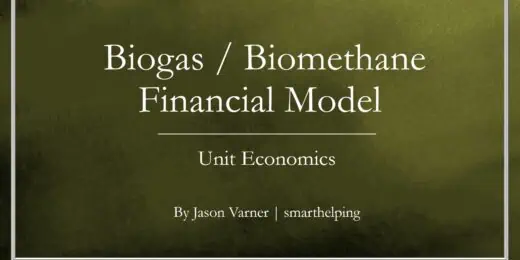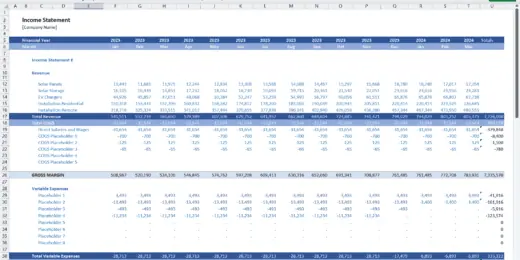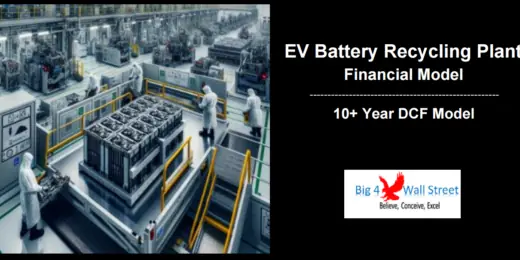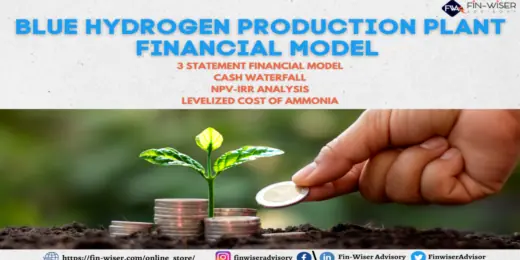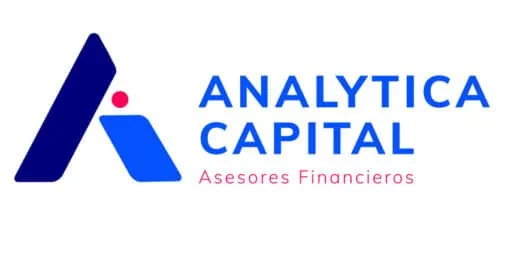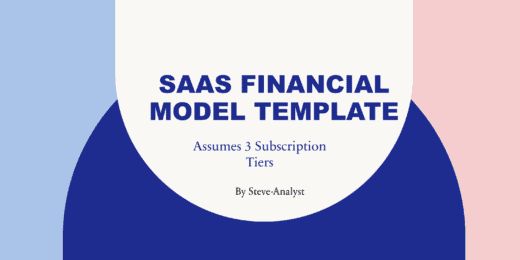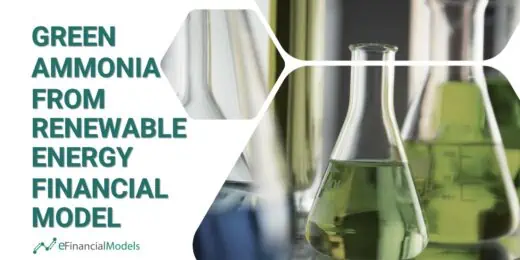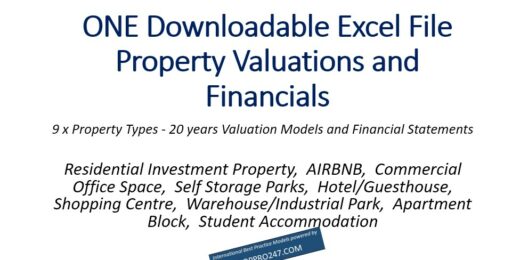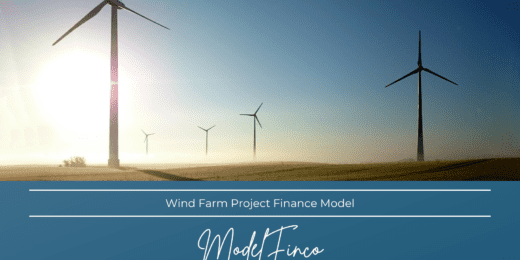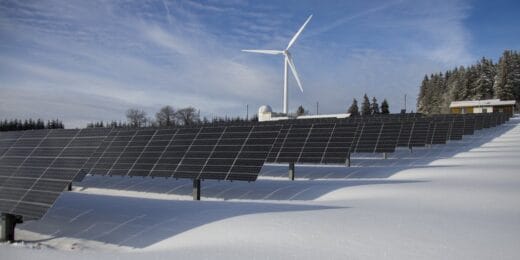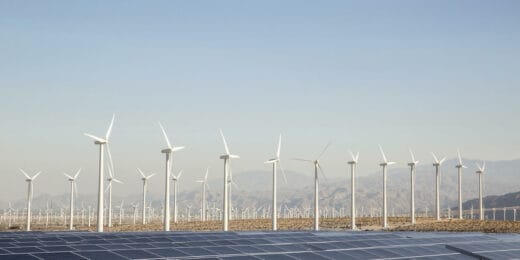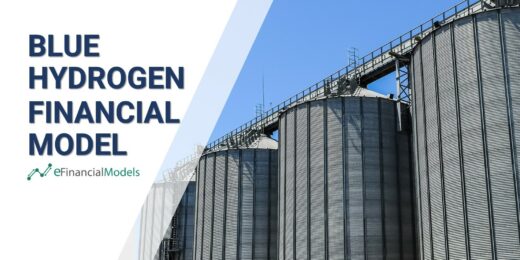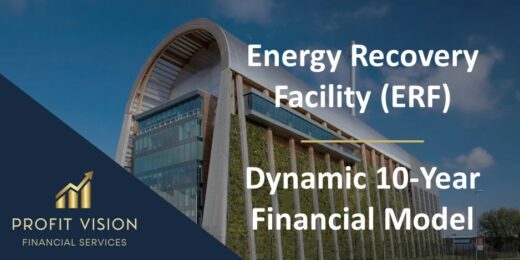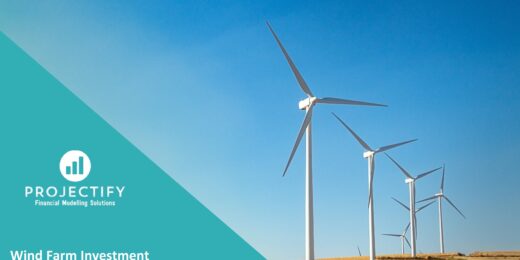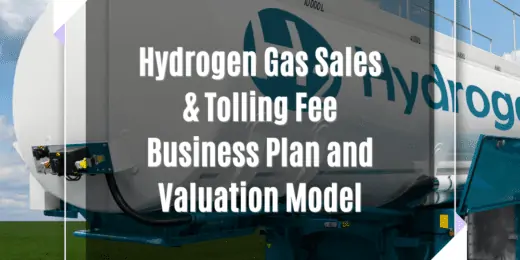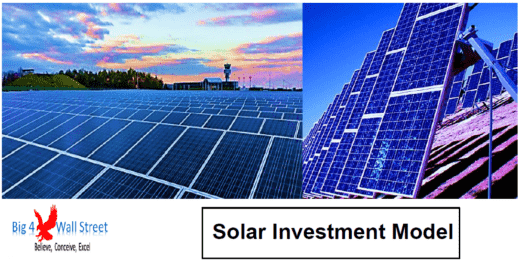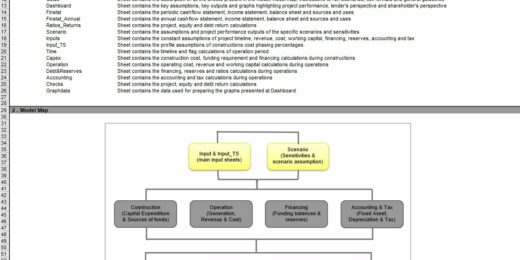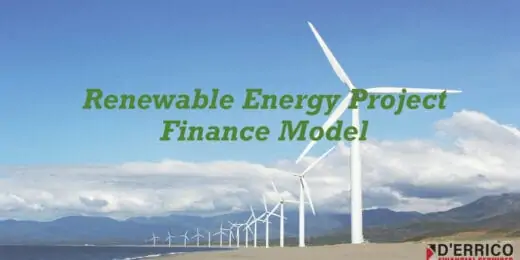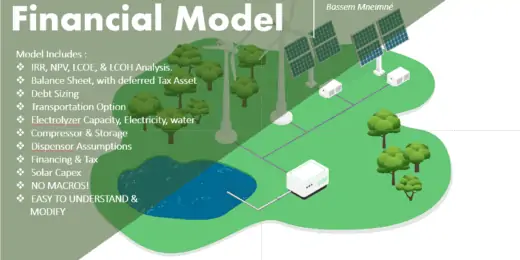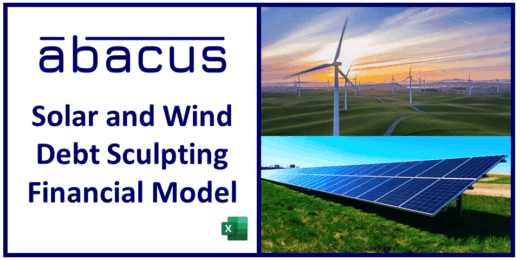Renewable Energy
You can craft compelling fundraising proposals using our models for financing renewable energy projects. These models also allow you to dive deep into renewable energy projects' financial health and potential. Our models offer thorough analysis tools, from cash flow projections to risk assessments, ensuring you make informed decisions.
Plan for the future with confidence. Our renewable energy project finance modeling templates allow for robust scenario analysis, helping you easily navigate the complexities of the renewable energy market. Budget effectively, forecast with accuracy, and prepare for various market conditions.
Biomethane Producer Financial Model (Renewable Natural Gas)
Create a detailed pro forma with this biogas financial model.…
5 Year 3 Statement Solar Energy Solutions Company Finance Model
A comprehensive editable, MS Excel spreadsheet for tracking Solar Energy…
Renewable Energy Financial Model
Comprehensive financial model designed for analyzing renewable energy projects, such…
Financial Modeling Mastery Bundle: Diverse Insights for Informed Decision-Making
Unlock financial expertise with our 'Diverse Insights Bundle.' Seven meticulously…
EV Battery Recycling Plant Financial Model (10+ Yrs DCF and Valuation)
The EV Battery Recycling Plant financial model is a comprehensive…
Blue Ammonia using Natural Gas – 3 Statements, Cash Waterfall & NPV/IRR Analysis
An integrated and comprehensive Blue Ammonia Production Plant Model that…
Blue Hydrogen using Natural Gas – 3 Statements, Cash Waterfall & NPV/IRR Analysis
An integrated and comprehensive Blue Hydrogen Production Plant Model which…
SaaS Financial Model Template – 3 Tier
This is a 3 tiered subscription model template with flexible…
Solar Farm (PV) Tax Equity – Fixed Partnership US
PV farm Tax Equity partnership in the US is designed…
Green Ammonia from Renewable Energy Financial Model
This comprehensive 40-year tool aid investors in evaluating potential risks…
Clean Hydrogen Production Project Economic Model
This is a detailed and easy-to-use hydrogen production from methane…
Discounted Big Bundle Real Estate Valuation and Financial Models
One Excel file for this bundle of Valuation and Financial…
Energy Project Finance (Infrastructure Model)
This is a special project vehicle (SPV) for an Energy…
Wind/Solar Power Generation (Renewable Energy) Financial Model
Financial Model to calculate Profit/Loss, accurately forecast financial statements and…
Energy Recovery Facility (ERF) – Dynamic 10 Year Financial Model
Financial model presenting a business scenario of a company owning…
Green Hydrogen (Electrolysis) Production Financial Model
This green hydrogen financial model template builds a multi-year financial…
Yellow Hydrogen from Solar Energy Financial Model
Deciding whether to invest or not in producing yellow hydrogen…
Green Hydrogen Production from Wind Energy Financial Model
The Green Hydrogen from Wind Financial Model aims to comprehensively…
Smart Recycling Bins Startup 5-Year DCF Financial Model
This model provides a comprehensive, detailed, and dynamic 5-year valuation…
Ethanol and Sugar Production Plant Financial Model
Fin-wiser’s Ethanol and Sugar Plant PPP project model helps users…
Green Hydrogen Project Financial Model (Electrolysis & Onsite Solar Plant)
A Project-Level Financial Model to assess the financial feasibility of…
Hydrogen Gas- Tariff Calculator with Integrated Financial Statement and Cash Waterfall
The Perfect tool to assess the financial feasibility, proposal to…
Windfarm Investment 3 Statement Financial Projection Model
User-friendly 3 statement yearly rolling financial projection Excel model for…
Geothermal Energy – Project Finance Model
Project Finance Model providing forecast and profitability analysis of a…
Hydrogen Gas Equipment Manufacturing and Sales Model – DCF Valuation Model
Hydrogen Gas Equipment Manufacturing and Sales Model – Discounted Cash…
Biomass to Hydrogen Gas PPP Project Model Template
Biomass to Hydrogen Gas PPP Project Model with 3 Statements,…
Hydrogen Gas Sales & Tolling Business Plan and Valuation Model
Hydrogen Gas Sales & Tolling Business Plan and Valuation Model…
Business Plan for a Biodiesel Manufacturing Plant
Setting up a biodiesel manufacturing plant requires a comprehensive and…
Investment in an Operating Solar (PV) Power Plant
Investment in an Operating Solar (PV) Power Plant is a…
Solar Farm Business Financial Projection 3 Statement Model
3-Statement rolling projection model for startup or existing business developing…
Renewable Energy Financial Models Bundle
A collection of user-friendly Project Finance Models in the Renewable…
Biogas (Waste to Energy) – Project Finance Model
Project Finance Model providing forecast and profitability analysis of a…
Wind Farm – Project Finance Model
Project Finance Model providing forecast and profitability analysis of a…
Solar (PV) Power Plant – Project Finance Model
Project Finance Model providing forecast and profitability analysis for a…
Renewable Energy Project Finance Model Template
The Renewable Energy Project Finance model is used to provide…
Solar Panel Manufacturing Plant Business Plan Financial Model Excel Template
Get the Best Solar Panel Manufacturing Plant Financial Model. Spend…
Renewable Natural Gas (RNG) Financial Model Template
This Financial Model Template in Excel provides an easy way…
Infrastructure Private Equity Wind Energy Modeling Test Solution (Associate level)
A self-made Modeling Test with a solution for Onshore Wind…
Green Hydrogen (Simple Electrolysis Financial Model)
The Model Incorporates data provided by different available sources to…
Geothermal Energy Feasibility Model Template
The objective of the Geothermal Energy financial feasibility model template…
Project Finance: Advanced Financial Model for Wind Power Generation Plant
Advanced financial model in Excel format for project finance simulations…
Abacus Solar & Wind Debt Sculpting Financial Model
Abacus is a bankable, easy-to-use, debt-sculpting financial model for use…
Renewable Energy Financial Model Template Bundle
Take this opportunity and get a discount by getting the…
Project Feasibility Template – Solar Rooftop
Solar Rooftop FM is a Project Finance Model for construction…
The Power of Renewable Energy Sources

Once upon a time, the world was heavily dependent on non-renewable energy sources like fossil fuels. However, as the negative impact of these resources on the environment became more apparent, people started looking for alternative sources of energy that were sustainable and safe. It led to the rise of renewable energy sources.
Over the years, renewable energy sources such as solar, wind, hydropower, biomass, and geothermal power have increased significantly. In 2023, the share of renewable energy sources in the global power mix increased to nearly 30%, marking a significant milestone in the world's transition to cleaner energy.
Harnessing the power of renewable energy sources is a pivotal endeavor in today's world, especially for entrepreneurs, investors, and capital providers. Understanding the intricacies of renewable energy projects is financially rewarding and contributes significantly to sustainable development. In this comprehensive exploration, we will delve into the critical role financial modeling plays in evaluating renewable energy initiatives' feasibility, profitability, and long-term viability.
What is Renewable Energy?
As we know, renewable energy is energy collected from natural resources replenished naturally. These energies include sunlight, wind, rain, tides, waves, and geothermal heat. Renewable energies are often used to provide energy in four areas: electricity generation, air and water heating or cooling, transportation, and off-grid energy supply.
Renewable energy resources exist worldwide and mainly in vast geographical areas, compared to other energy sources limited to specific regions. Support for renewable energy has produced excellent results in energy security, climate change mitigation, and increased economic benefits. Thus, this has pushed the renewable energy sector to continuously grow strongly, not just nowadays but also in the future
The best thing about renewable energy projects is they help rural areas without access to other energy sources. These projects are usually large, and the technologies used are perfect for rural areas and are still being developed. Plus, today's renewable energy systems are rapidly advancing to be more efficient and affordable. Thus, people will not depend on other limited energy sources, e.g., coal, oil, etc.
What are the Types of Renewable Energy Resources?
Renewable energy resources have emerged as a critical pillar in the global pursuit of sustainable and environmentally responsible energy solutions. There are various types of renewable energy resources, shedding light on their characteristics, applications, and immense potential for shaping the future of energy generation and consumption. Gaining insights into these renewable energy options will better equip you to make informed decisions, seize investment opportunities, and contribute to a more sustainable and prosperous future.
Solar Energy
Solar energy is derived from the sun's radiation and harnessed through various technologies, including photovoltaic (PV) solar cells, thermal systems, inverters, and energy storage systems. Solar energy production does not emit greenhouse gases or pollutants, making it environmentally friendly and sustainable. However, it is intermittent and dependent on sunlight. It is available during the day and varies with weather conditions and geographic location.
Solar energy has many applications, including residential solar panels on rooftops, commercial PVs to power offices and factories, solar-powered vehicles, and large-scale solar parks. Starting a solar installation company or providing maintenance services for solar systems is a viable business opportunity. Developing or investing in large-scale solar farms can generate substantial returns through energy sales and government incentives. Battery technology for storing excess solar energy is in high demand, offering opportunities for innovation and investment.
Wind Energy
Wind energy comes from the kinetic energy of moving air, primarily driven by the sun's uneven heating of the Earth's surface. It is environmentally friendly, producing no greenhouse gas emissions or air pollutants. It relies on a naturally occurring resource, making it sustainable over the long term. The effectiveness of wind energy generation is highly dependent on geographic location. Wind farms are typically situated in areas with consistent and strong winds, such as coastal regions or open plains. Wind energy systems can range from small-scale residential turbines to large-scale wind farms with multiple turbines. This scalability makes it suitable for various applications.
The most common application is generating electricity through wind turbines. These turbines convert the wind's kinetic energy into electrical power, which can supply homes, businesses, and industries. It can also pump water in rural areas or for agriculture, providing a sustainable water source without grid connections. Often, wind turbines are used in remote locations or off-grid areas to provide power where conventional electricity infrastructure is unavailable or costly to install. Investing in the development and operation of wind farms can offer stable returns over the long term, especially in regions with consistent wind resources. Manufacturing wind turbines and related components can be lucrative, as their demand is expected to grow..
Hydropower
Hydropower, or hydroelectric power, harnesses the energy from flowing water to generate electricity. It produces minimal greenhouse gas emissions and has a lower environmental impact than fossil fuels. Hydropower projects can range from small, run-of-river systems to large dams with reservoirs. Its availability of hydropower on seasonal and weather conditions, as it relies on water flow. Hydropower is primarily used to generate electricity. It can provide a consistent power source for homes, industries, and businesses. Large hydropower plants with reservoirs can serve as baseload power sources, providing a stable and continuous electricity supply.
In addition to electricity, hydropower projects often provide water for irrigation, drinking, and other essential needs. Some hydropower dams are designed to regulate water levels and prevent floods. Existing hydropower plants can benefit from technological upgrades and efficiency improvements, offering investment potential. Small-scale and run-of-river hydropower projects can attract investors who want to support local, sustainable energy generation. Furthermore, investing in constructing and maintaining hydropower facilities can be lucrative, especially in regions with abundant water resources.
Biomass
Biomass refers to organic materials derived from living or recently living organisms, such as plants and animals. It is a renewable energy resource that can take various forms, including wood, agricultural residues, energy crops (e.g., switchgrass), and even organic waste materials like food scraps. Biomass is continuously replenished through natural processes. Plants can be grown and harvested regularly. When burned for energy, the carbon dioxide (CO2) released is roughly equivalent to the amount plants absorb during growth. It results in a near-zero net increase in atmospheric CO2, making biomass carbon-neutral.
Biomass can be burned in power plants to produce electricity, especially in regions with abundant biomass resources. It can also be used for residential heating, industrial processes, and district heating systems, reducing reliance on fossil fuels. Organic waste materials can be converted into liquid biofuels like biodiesel and bioethanol, which are used in transportation as alternatives to gasoline and diesel. Investing in biofuel production facilities, such as biodiesel or bioethanol plants, can capitalize on the growing demand for renewable transportation fuels. Building and operating biomass power plants can be lucrative, especially in areas with abundant biomass resources. These facilities can sell electricity to the grid or local consumers.
Geothermal Power
Geothermal power harnesses the natural heat from within the Earth to produce electricity. It relies on the Earth's internal heat, which is inexhaustible on human timescales. Geothermal power plants have very low greenhouse gas emissions compared to fossil fuel-based power plants, making them environmentally friendly. Unlike solar and wind energy, which are intermittent, geothermal power is consistent and can operate 24/7, providing a stable source of electricity. However, they are location-specific and are typically found near tectonic plate boundaries or hotspots, limiting their geographical distribution.
The primary use of geothermal power is to generate electricity. Power plants use geothermal fluids from underground reservoirs to turn turbines and produce electricity. Geothermal heat pumps are also used for residential and commercial heating and cooling systems. They are highly efficient and can significantly reduce energy bills. Geothermal heat pumps can also be used for various industrial processes, such as drying crops and pasteurizing milk, and even in spa resorts. The market for geothermal heat pumps is growing as more people seek energy-efficient heating and cooling solutions. Investing in manufacturing or distributing these systems can be profitable. Investing in the development of geothermal power plants can yield long-term returns. Companies specializing in geothermal exploration and drilling services are essential for locating and tapping into geothermal reservoirs. Investment in such ventures can be lucrative.

Other Types of Renewable Energy Resources
Other renewable energy resources, apart from the well-known ones, play a crucial role in diversifying our energy mix and reducing our reliance on fossil fuels.
While not a direct energy source, hydrogen can be considered a renewable energy carrier. It can be produced through electrolysis using renewable electricity and used in fuel cells for various applications, including transportation and power generation.
Ocean thermal energy utilizes the temperature difference between warm surface waters and cold deep waters. This temperature gradient can produce electricity through ocean thermal energy conversion (OTEC).
Tidal and wave energy captures ocean tides and waves' kinetic and potential energy. Specialized devices, such as tidal turbines and wave energy converters, generate electricity as the tides and waves move.
Piezoelectric materials generate electricity when mechanical stress or vibrations are applied to them. This technology can be used in small-scale applications like powering sensors or wearable devices.
These alternative renewable energy sources offer various opportunities to reduce greenhouse gas emissions and promote sustainability in different economic sectors. Their adoption often depends on local geographical and environmental conditions, technological advancements, and economic feasibility.
Financing Renewable Energy Projects
Starting renewable energy projects are not just like any projects, there is a critical need for a huge capital to shoulder all the needed expenses to even start one. Aside from financing renewable energy projects, in developing countries, there are many factors that can hinder the development and use of renewable energy. It could be lack of market transparency, lack of financing, ignorance about the project development, and lack of information on regulations, markets, and resource availability. Thus, resulting in only a few projects proposed and investors confused on which projects are profitable for them.
Let's explore how different financing options in the renewable energy industry:
- Bonds are debt securities issued by renewable energy project developers to raise capital. Investors purchase these bonds, and the issuer commits to repay the principal with interest over a specified period. Bondholders often require assurance of stable cash flows to invest, making accurate financial projections vital. So, you can use financial models for bond financing, including estimating the project's cash flows, determining the repayment schedule, and calculating the debt service coverage ratio (DSCR).
- Equity capital involves raising funds by selling ownership stakes in the renewable energy industry. Investors become shareholders and share in the project's profits and risks. Equity financing models focus on estimating the project's potential return on investment (ROI) and assessing the risk-adjusted returns for investors.
- Government grants cover a portion of the project's costs, reducing the financial burden on developers. Accurate modeling helps in demonstrating the project's feasibility to government agencies. Financial models for government grants should outline the expected grant amounts, disbursement schedules, and their impact on project economics.
- Mezzanine financing combines elements of debt and equity financing. It includes subordinated debt and convertible securities, offering investors a hybrid form of investment. Sensitivity analysis can help assess the impact of various scenarios on returns. Mezzanine financing models account for the debt component's interest payments and the equity component's potential conversion into equity.
- Project Finance is a common approach for large-scale renewable energy projects. Project finance involves creating a separate legal entity for the project and securing debt and equity financing based on its cash flows. Financial modeling is critical for attracting institutional investors and lenders. Project finance models are extensive and detailed, covering every aspect of the project's finances. They include cash flow forecasts, debt structuring, risk analysis, and scenario modeling.

To venture in the renewable energy sector, one must do a feasibility study to ensure that you will have substantial information regarding the factors needed to not be hindered upon starting a renewable energy project. If financing renewable energy projects is your goal, as an investor, you will also need to do a lot of research or create an investment model to ensure that the project you’re investing will be financially feasible.
Renewable Energy Project Finance Modeling
Are you planning to start a business in the renewable energy industry? Do you want to know how to ensure that your business will be financially feasible for the coming years? Are you in need of a proper valuation method to evaluate the projects or businesses in renewable energy sector, if it’s worth investing for? Or are you looking for a good financial model to showcase your business’s financial feasibility towards investors and venture capitalists for funding, and also banks for loans? Here we have a list of renewable energy project finance modeling templates in Excel. These excel spreadsheets can be used as your basis for a business plan and mostly focus on the financial feasibility of an investment in solar, wind, biogas and other renewable energies. Giving you a more efficient way to calculate everything you need for your financial model. It is also very easy to download and edit, to be able to apply the figures of your company and the financial model will calculate everything for you. No need to be an expert in financing as the excel template will do the job for you.
Why offer templates instead of creating one from scratch? Not all are experts in creating a financial model, plus it takes a lot of time to research and compile all you need to finish one. Efficiency is key in every business, so if you can save time for a lesser cost then that’s the best way to go about it, especially in this generation where working fast is preferable. If you are looking for a specific financial model template and couldn't find it in our inventory, feel free to comment here: Missing Financial Model Templates, so that our Vendors will pick up that project and will soon add in our still growing inventory. If you found the template but need help with customization of your preference, we also offer financial modeling services which you can avail here: Custom Financial Modeling Service. We would be really grateful if you also rate our products and leave a review, comments, suggestions, or any kind of feedback, about our financial model templates, for this will greatly help us shape our templates to be even better in the future.


